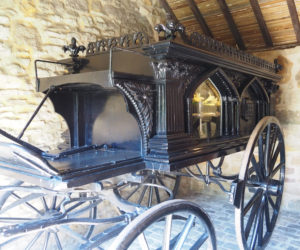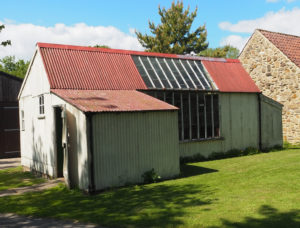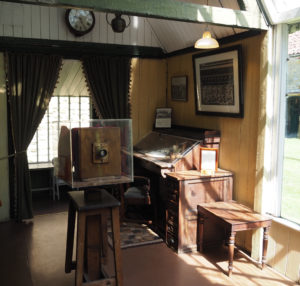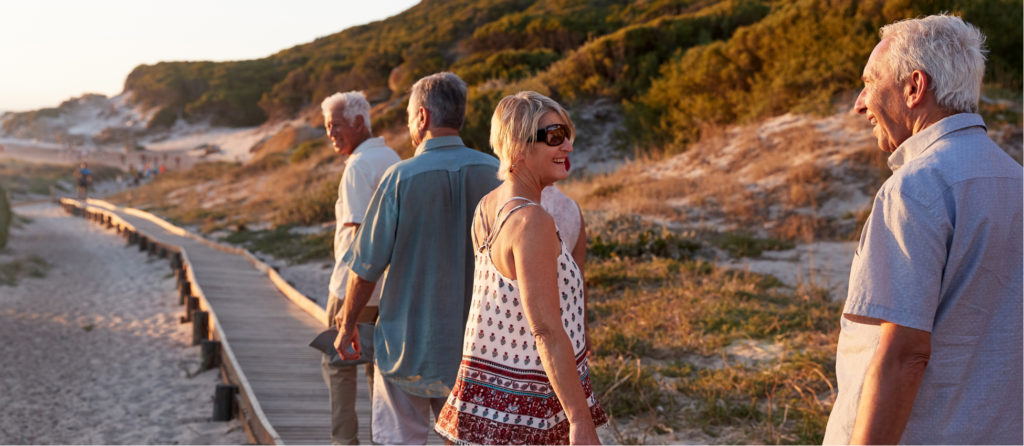The VILLAGE STORE was the centre of community life providing a place to receive news and gossip. The shop is set up to show a typical village shop from the 1950s which sold everything from fresh food, bread, vegetables to tinned and packet goods. It also sold household cleaners, pots and pans and haberdashery.
Many good were sold loose and weighted out.
In a corner was the post office, which sorted out letters for delivery. It also despatched fresh food like eggs and also dealt with wireless interference complaints!
The CHEMIST SHOP is recognisable by the red and blue carboys in the window. Originally these contained medicinal liquids like rosewater, but by the twentieth century their function became symbolic and they were filled with brightly-coloured liquids.
The chemist originally made up his own prescriptions from dry ingredients stored in labelled drawers or liquid ingredients in bottles. Ribbed bottled were used for poisonous liquids.
A pestle and mortar was used to grind up ingredients which were then mixed to a paste . The mixture was then rolled into a thin sausage on the board of a pill making machine
using a flat paddle. The sausage was then rolled backwards and forwards over the grooves to cut the pills.
As well as treating humans, in rural areas, the chemist would also make up medicines for farm animals.
In rural areas, the UNDERTAKER was often a joiner, carpenter or builder as well as the undertaker.
The magnificent horse drawn hearse hearse bought by the inhabitants of Farndale in 1839. Each household was asked for a contribution according to their pay. The hearse was bought second hand at the bargain price of £17. A new one would have cost £60.
The smaller hand drawn bier would have been used for cheaper funerals. The rope covered wheels allowed it to be rolled quietly along the cobbled streets. The coffin was lifted from the wheeled base to be carried to the grave.
The room behind the biers is the office and in true Victorian style is very cluttered. Hanging behind the door is the undertakers black coat and top hat. There are examples of Memorial cards, carefully cut out from embossed white paper and mounted on black card. These were sent to show respect to the bereaved.
PHOTOGRAPHY really began to take off in the mid C18th with the daguerreotype process which allowed photographs to be taken with only a short exposure. and making commercial viable businesses to develop. Subsequent innovations made photography even better and everyone wanted their photograph taken.
The DAYLIGHT PHOTOGRAPHIC STUDIO at the museum is the oldest daylight photography studio in England and includes a dark room and finishing room.
William Hayes built a photography studio in Monkgate, York in 1902 with large windows providing enough light for photography. After concerns about the air quality in York, Hayes dismantled his studio in 1911 and transported it by horse and cart to Hutton le Hole and re-erected it. It was a thriving business, producing postcards and photos of local scenes. These were used as the backdrop for studio portraits, in a drawing room situation with potted plants and furniture, to help relax the sitter.
Natural light was the preferred source of lighting. Arc lamps were noisy, smelly and dangerous to operate. The windows in the studio are large and made up of recycled glass negatives, stripped of their emulsion.
The adjoining darkroom and finishing room meant plates could be developed while the subject waited. They would only leave once William was satisfied with the results.
There are lots more pictures “here.”:https://www.sloweurope.com/community/threads/hutton-le-hole-and-the-ryedale-folk-museum.5978/ here.










